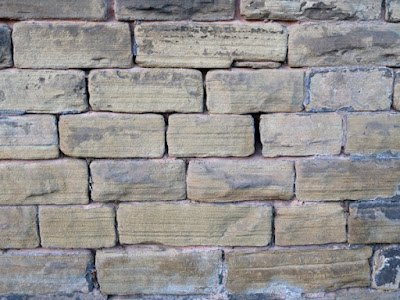Starting at the Towers, during my brief investigation of the area between Sandygate Road and Stumperlowe, I had encountered very many examples of the Chatsworth Grit used for general walling, gatepiers, roads and pavements and Rough Rock for stone roofing tiles, at least, with another sandstone that could be the Crawshaw Sandstone from the Ranmoor quarries.
At the end of Stumperlowe Lane, at the junction with Fulwood Road, the boundary wall here is made of flaggy sandstone, with a high proportion of blocks that have dark rusty brown staining on the joint planes – a feature that I had begun to associate with the Rough Rock.
I quickly walked down Fulwood road until I reached the Nether Green Junior School, formerly the Ranmoor Council School, where I took a few photos of the Grade II Listed gates, railings and boundary wall, which I had forgotten to take on my previous visit.
When walking down towards the school, I was interested in the wooded area known as Carr Bank Wood, which occupies a quite a deep and steep sided valley to the south of Fulwood Road. I retraced my steps and had a quick walk along Carr Bank Lane, from which I got a good view of the relatively clean sandstone exposed on the south elevation of the school.
The BGS GeoIndex online map shows a small outcrop of Crawshaw Sandstone, which forms an escarpment along which Carr Bank Lane runs. Although there are no clear exposures of the sandstone, a few small blocks can be found lying around the upper part of the bank and the solid rock is not too far from the surface.
In one place, the roots of a large tree growing on the upper bank have grown around large lumps of sandstone, which look very dark in colour, but I did not have my Estwing hammer with me to try and obtain a sample from these.
From the loose blocks that I could find, however, I did manage to break off a couple of pieces into a size that I could take home. One is a mud coloured silty sandstone, which is highly laminated, micaceous and has carbonaceous inclusions, with the other being a distinctly reddened fine grained sandstone, with some cross-bedding.
Returning to Fulwood Road, I took a quick diversion up Graham Road, where there is a further example of garden landscaping using stone cleared from the fields, yellow gritstone gatepiers and massive capping stones used for the overbridge carrying Stumperlowe Crescent Road.
Walking down to Ranmoor, there are yet more examples of Chatsworth Grit in a variety of gatepiers – some of which are inscribed – boundary walls that have the same coarse texture and grey colour as seen along Sandygate Road and more garden landscaping.
Passing through Ranmoor, I had another quick look of St. John’s church, which didn’t provide me with any more clues to the provenance of the sandstone walling, before continuing down Fulwood Road – passing another uniformly buff coloured wall that looks like it is built with planar bedded Crawshaw Sandstone.
Having already walked 8 km over a period of 3½ hours, I ended my day at The Florentine hotel, which was originally built in 1865 as Moordale for the Sheffield industrialist James Nicholson, who operated the Mowbray Steel Works at Kelham Island and is commemorated with a fine monument at Sheffield General Cemetery.
I had a quick look at its east and north elevations, where there are some spectacular dragons at eaves level, but I didn’t study the stonework in any detail; however, the walling stone looks like it again could be Crawshaw Sandstone, with Derbyshire gritstone used for the very elaborate door surround on its east end.
On this occasion, I didn’t take advantage of the refreshments on offer at The Florentine and only took a few photos of the various details of the surround to the east door, which I would use in my forthcoming illustrated talk to the Ranmoor Society.














No comments:
Post a Comment